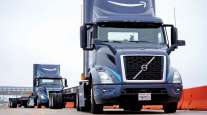Staff Reporter
ATRI: California’s Zero-Emission Goal Comes at High Cost

[Stay on top of transportation news: Get TTNews in your inbox.]
California’s race to have near-total-zero-emission passenger vehicles and heavy trucks will result in a greater need for electricity at higher prices and more commercial vehicles to deliver today’s amount of freight.
These findings and others are based on a new analysis released Dec. 18 by the American Transportation Research Institute called “Is California Ready for an Electric Vehicle Future?”
With California instituting aggressive laws (being copied by other states) to eliminate carbon fuels from its interstate transportation, ATRI took a microscope to view a likely impact of a full EV evolution. ATRI’s new analysis is a companion to its December 2022 report “Charging Infrastructure Challenges for the U.S. Electric Vehicle Fleet.” That report determined that full electrification of the U.S. vehicle fleet would need much of the nation’s present electricity. Domestic longhaul trucking would use more than 10% of today’s electricity, and an all-electric U.S. vehicle fleet would use more than 40%.
At present, California has enacted greenhouse gas emission-reduction laws ordering trucks and buses operating there to transition to 100% zero-emission transportation where feasible by 2045. The state also set a target for 100% of in-state sales of new passenger cars and trucks to be zero-emission by 2035.
ERoad's Craig Marris gives advice on carving out a practical, effective road map to a greener and more efficient fleet. Tune in above or by going to RoadSigns.ttnews.com.
ATRI’s latest forecast notes that state mandates would result in California having to generate 57.2% more electricity than today’s output of 197,000 gigawatt hours (GWh), which is insufficient to meet present demand. That means California must now import 50,000 GWh to provide the state with adequate electricity supplies.
If California’s EV plans are met, the state will need to consume 57.2% more electricity than it does today, according to ATRI’s earlier report.
After Hawaii, California has the second-highest average kilowatt hour cost for electricity (at 22.33 cents), according to a U.S. Energy Information Administration national electricity profile for 2022, which are the latest figures available.
“With new battery-electric vehicle trucks costing more than $425,000 — more than double the cost of a comparable diesel truck — California’s supply chain will get more expensive. Additionally, the cost to power a battery-electric truck, including equipment, installation, utility upgrades and electricity, could be as high as $1.21 per mile, nearly double the cost per mile of diesel fuel,” ATRI stated.
Want more news? Listen to today's daily briefing above or go here for more info
EV charging for trucks also will spark another financial cost in truck parking facilities (already falling significantly short of demand).
“Adding a charger at each of California’s 13,144 truck parking spaces would cost between $1.472 billion and $2.878 billion for just the purchase and installation of the charging units,” ATRI noted.
Another consequence facing California is that EV batteries translate into heavier vehicles on roadways and bridges, many of which today are aging and need of repairs or replacement.
ATRI contends data from its 2023 Operational Costs of Trucking report demonstrates that one-third of the truckload sector would suddenly be too heavy for U.S. roads if today’s diesel tractors are replaced with much heavier electric trucks.
This electrification of the industry in California would result in more EV trucks needed to move the same amount of freight as a diesel truck.
“For every 1,000 trucks, an additional 343 trucks would be required due to battery weight,” ATRI stated.





